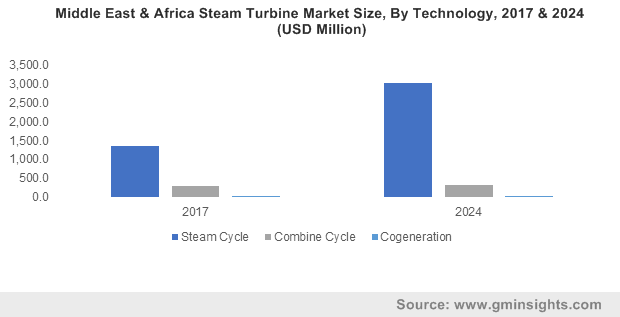Steam turbine market valuation to exceed $24 billion by 2024, substantially increasing global energy demand to stimulate the industry growth
Publisher : Fractovia | Published Date : 2018-11-15Request Sample
The steam turbine market has remained strong in an era where renewable energy sources like wind and photovoltaics have threatened to dethrone coal as the number one source of fossil fuel used to generate energy. This is mainly because renewable sources of energy, in spite of having gained importance, fluctuate too often and therefore create a very destabilized power system. While newer technologies are being brought into play and future power supply options are being developed to supply power in a stable manner, power supplied by steam turbines has remained the backbone of the power system.
Europe Steam Turbine Market Size, By Capacity, 2017 & 2024 (USD Million)

It is to be noted that expert estimates show coal to be still representing 30% of the global energy consumption and providing 40% of the electric supply in the world. Coal has remained the chief fossil fuel that still supplies a bulk of the energy in many countries, especially the ones with emerging economies. With rapid urbanization and industrialization trends noted in such countries, the demand for power supply is growing by the hour, contributing to the growth of steam turbine market.
China and India can be considered as two very good instances of countries that have been depicting the latest trends proliferating steam turbine industry. According to the International Monetary Fund, India, in the recent years has emerged as one of the fastest growing economies in the world with a forecast rate of 7.8% until 2020. The Make in India program has placed the country in the world map as a manufacturing hub and added momentum to the manufacturing industry owing to which the demand for power has considerably increased, a trend that will continue over the forthcoming years.
As energy intensive segments like cement and steel as well as process co-generation sectors like paper & pulp, chemicals and sugar, are on the rise, steam turbine industry has been registering new application avenues. Not only in India, but in countries like the U.S. where renewable energy sources are gathering a stronghold, shifting governmental policies in coal utilization, the burgeoning industrial sector and withdrawal of the federal government from the Paris Climate Accord are expected to add further impetus to the U.S. steam turbine industry. Notably, U.S. accounted for more than 70% of the North America steam turbine industry revenue in 2017.
As rising awareness about negative effects of greenhouse gases and the depleting source of fossil fuel has raised serious concerns, the steam turbine industry has evolved to contribute to the sustainability of the environment by involving the use of fossil fuel alternatives. Solar power, biomass and waste-to-energy are some of the instances that have already illustrated capacity to act as solutions to problems that have threatened to slow down the steam turbine market. Waste-to-energy conversion that uses municipal solid waste and agricultural waste (biomass) to be incinerated at high temperatures and passed under high pressure to produce steam that fuels steam turbines to generate electricity are becoming green options for the steam turbine industry. Since in case of waste to energy, cost of the fuel is virtually non-existent, and in many cases, revenue is actually generated when waste is disposed of, it represents a viable energy alternative to fossil fuels which are non-renewable and cost money.
Retrofitting of older steam turbines in established economies is also expected to play a significant role in generating revenue in the steam turbine market. Steam turbine retrofits are performed to achieve improved power output, turbine efficiencies or heat rate output besides addressing maintenance issues and turbine reliability. Steam turbine performance can be improved with the incorporation of new technologies and can also extend maintenance intervals besides extending steam turbine life cycle. For instance, Toshiba Energy Systems & Solutions Corporation recently announced that it has won steam turbine retrofitting contract at the Aioi Power Station of Kansai Electric Power in Hyogo, Japan. The fuel for the retrofitted unit would be changed to woody biomass thus keeping pace with the changing environmental needs while improving efficiency of aging thermal power plants all over the world
As instances of retrofitting older stamen turbines are on the rise, many new thermal power plants are already under construction or are being planned for the future thus holding strong growth opportunities for the steam turbine market over 2018-2024.